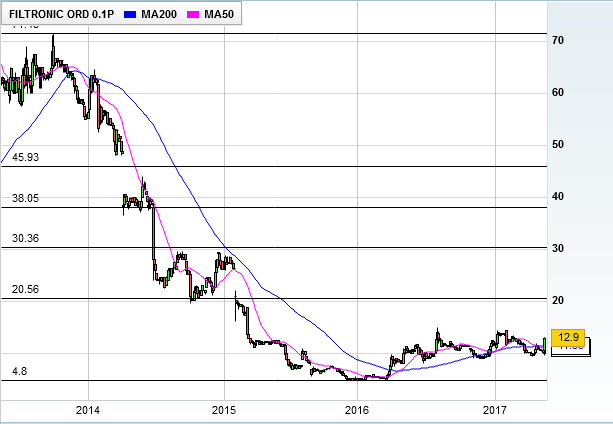Another tick in the box, but can Filtronic double again?
12th May 2017 12:19
by David Brenchley from interactive investor
Share on
is the classic dotcom boom and bust chart. Founded by professor David Rhodes in 1977, the designer and manufacturer of microwave electronics for the wireless telecoms market listed on the London Stock Exchange back in 1994. But after a meteoric rise to stardom, the good times were short-lived.
At the height of the technology boom in February 2000, the stock peaked at £23.50, as investors piled into the sector in the hope of finding the next 'ten-bagger'. In the space of just a year Filtronic's shares had doubled and the loss-making business was valued at around £1.5 billion.
Within a year, the share price had collapsed by 86% to 326p. It was never to recover and now, 16 years on, you can pick up the shares for 12.75p, giving a market cap of just £29 million.

Still, it survived, and shares in the West Yorkshire firm just rocketed by almost a third to a high of 13p Friday after a very short but very sweet trading update.
"Trading during the fourth quarter of the current financial year in the Filtronic Wireless business has been ahead of previous management expectations," it said.
Filtronic now expects group revenue of £35 million for the year to 30 May 2017 - up 158% - "with a commensurate increase to operating profit, both of which are ahead of market expectations".
This is "despite some marginal, short-term weakness in trading in Filtronic Broadband", the division that makes microwave products and millimetre wave transceiver modules and filters for the telecoms, aerospace and defence industries.
Broadband is on an improving trend, though, says Adrian Kearsey, analyst at house broker Panmure Gordon and fan of the company. It will be boosted by an already-announced multi-year agreement to supply a major defence-aerospace company worth £13 million of net revenues starting next year. As the customer will pay for materials, much of that revenue will drop straight to the bottom line.
Despite a bounce from just 5p 14 months ago, Kearsey reckons there's much more to come from Filtronic, reiterating his 29p price target, implying further upside of over 127%.

The analyst explained that the jump in sales activity reflects both shipments of the new ultra-wide band integrated antennas and strong underlying demand for filter products. He raises his full-year operating profit estimate 43% to £1.6 million.
Filtronic Wireless - which makes parts and antennas for telecoms equipment manufacturers and network operators - is leading the way and, "whilst orders are concentrated in terms of client, they offer a good reference point [and] provide the enhanced sales team a platform to build future sales".
"Operational leverage and re-positioning of the cost structure mean that a good proportion of sales is dropping through to earnings," adds Kearsey, who expects a FY2017 drop-through rate of 39-40%. In the first half it was 34%.
Clearly it's not been an easy road both for investors and management - short-term as well as in the longer run. A succession of profit warnings back in 2014 saw the stock lose half its value that year.
In March 2016, after a couple of very difficult years, Panmure placed its 'hold' recommendation under review. Twelve months ago, it suggested the firm "appears to have got its mojo back" and, six weeks later with the price at 10p, the broker upgraded the shares to a 'buy' and slapped a 24p target on them.
While then analyst George O'Connor admitted this was "a first stab until we have greater clarity as to the operational backdrop for 2017E and beyond", Panmure's faith in the business is finally being repaid.
That 24p was upgraded by 5p in August to the current objective. "All in all," Kearsey says, "[it's] another tick in the box for Filtronic."
This article is for information and discussion purposes only and does not form a recommendation to invest or otherwise. The value of an investment may fall. The investments referred to in this article may not be suitable for all investors, and if in doubt, an investor should seek advice from a qualified investment adviser.